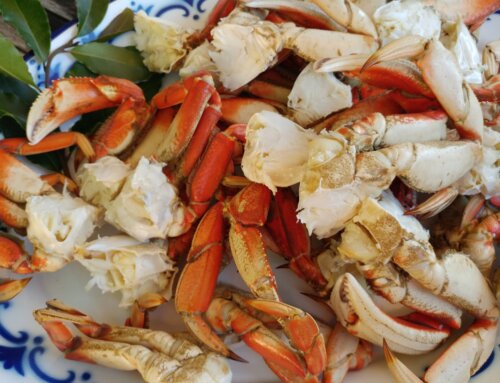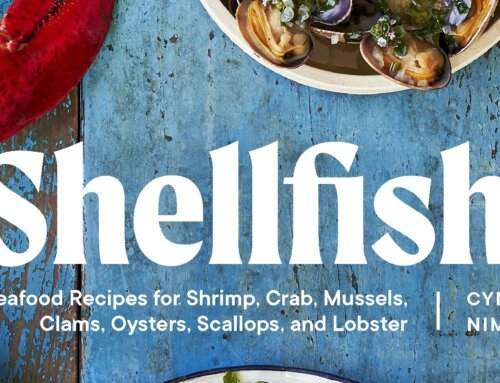It was a simple enough question, but it caught me off guard. “Can you recommend a cookbook for the basics, for someone starting out in the kitchen?” Paraphrased, that’s what was posed to me by someone a few weeks ago at one of my book signings.
Um. Well. Gee. I told her about Mark Bittman’s How to Cook Everything, but recalling its heft and text-dense style, I worried to myself that it might intimidate a first-time cook. Beyond that, I was at a loss. (He’s got a How to Cook Everything: The Basics
variation on the theme, which I discovered later, it seems more user-friendly with more visuals and a lighter design.)
If she’d asked about making crackers (Salty Snacks, of course), or the hottest new vegetarian book (Plenty
), or something tantalizingly exotic (The Food of Morocco
) I’d have had the answer. But her question stumped me. All this story-telling and creative recipe development and adding one more book of a contemporary theme to the cookbook world, and it’s like I lost sight of that simple basic question: what does it take to encourage a newbie in the kitchen to build the skills and gain the confidence to become comfortable with cooking? To feel articulate enough in techniques and ingredient combinations to
 develop their own culinary personality and style?
develop their own culinary personality and style?
My goal with every recipe I write and every book I put out is to provide encouragement, advice, gentle nudging. I try to keep jargon, unusual ingredients and fancy equipment to a minimum and do my best to figuratively take readers by the hand as they walk through a recipe. So I hope that, in my own way, I’ve been contributing to the confidence-building and comfort that folks can benefit from when they cook.
My own experience becoming comfortable and confident in the kitchen has been a long journey with many different stages. Growing up with a mother who loved to cook was a great start, I inherited the basic enjoyment she had for preparing meals. (When I was in high school we even cooked little dinner parties in peoples’ homes as auction items for church fundraisers.) I’m a pretty good book learner when the reading can be immediately applied to a hands-on experience, so I used to buy up cooking magazines at garage sales and cooked from them as part of my self-styled education. (It’s how I learned to knit, too, a copy of Vogue Knitting and 6 or 8 skeins of yarn to practice on.) Eventually going to culinary school in France certainly sealed the deal.
One of my earliest cookbooks — one that I haven’t cooked from in many many years but can’t bear to part with — is Better Homes and Gardens Complete Step-By-Step Cookbook. Published in 1978 (I was probably in junior high when I got it), the book has rather uninspired black & white photos showing the steps for stuffing a pork chop and making baked custard. But it’s a book I paged through countless times early on, picking up techniques, learning about traditional recipes, finding something fun to cook next. I can tell from the most-splattered pages and where I made notes in the book that I tackled Cranberry Cornish Hens, Crepes and Meringue Shells. I seemed to have skipped the “Skipper’s Linguine” with bacon, canned tuna and pitted ripe olives and “Frozen Fruit Slices” (cream cheese, mayonnaise, tiny marshmallows, fruit cocktail). It was a product of its time, to be sure, but was a great tool for me.
I repeated the question that stymied me on Facebook, asking my pals there for recommendations of cookbooks for novice cooks. I got a lot of interesting feedback, citing titles from The Fannie Farmer Cookbook and Joy of Cooking (each of which got multiple nods) to Jamie Oliver’s Cook with Jamie
and Alice Waters’ The Art of Simple Food
.
One book mentioned that I hadn’t come across yet was Keys to the Kitchen by Aida Mollenkamp. Flipping through the review copy I just received, I see it’s got a no-nonsense presentation of information, simple graphic style (with line drawings and unfussy close-up photos), and a conversational, engaging tone. By contrast, my BHG book has a more stilted, formal style of presenting information. And newer books do a far better job of prepping cooks before they heat a single burner on the stove. Tips about basic tools and equiment to have on hand, how to stock the pantry, best shopping practices, how to store food when it’s back home, safety notes, etc. I love the mod
 approach Mollenkamp takes with her chef’s notes, an ingredient or cooking step underlined with dots–reminiscent of a hotlink on a web page–with the related note off to the side in the column. A clever effect that those who consume most of their recipes online will respond to.
approach Mollenkamp takes with her chef’s notes, an ingredient or cooking step underlined with dots–reminiscent of a hotlink on a web page–with the related note off to the side in the column. A clever effect that those who consume most of their recipes online will respond to.
Recipes cover the gamut well and do good justice to modern tastes with few old-school traditional recipes. I love the idea of Broiled Swordfish with Pomegranate-Mint Agrodolce and thought Caramelized Fennel Tarte Tatin sounded pretty tasty. And her last chapter is just great, “The Riff,” helping folks get out of the following-a-recipe grind and learn how to improvise and cook off-the-cuff. The few dozen brief preparations–such as Tomato-Masala Soup and Simple Peanut Noodles–are presented in narrative paragraph form like she was just chatting with you on the phone about what to cook tonight. I’m all for recipes, they’re the backbone of my work, but I’m fully on board with encouraging cooks to learn from recipes but not feel tethered to them.
It was good to be prodded to check out the current generation of “welcome to the kitchen” books. Seems like there’s never been a better time to be a novice cook.



